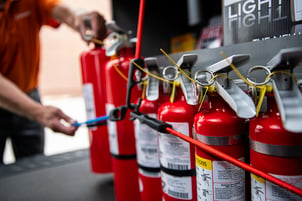
If a small fire breaks out in your home or workplace, your first instinct might be to reach for a fire extinguisher. But, do you know how to use one if you need to?
When it comes to using a fire extinguisher, they are only effective if you know how to operate it – and know which kind to use.
Below, learn the basics of extinguishers and classes of fires, proper usage, and common mistakes, so that you can be as prepared as possible if the time comes.
Types of Fires & Extinguishers
For residential and commercial fires, there are five classes of fires that can occur:
-
Class A: Fires fueled by something solid, such as wood, paper or cloth.
-
Class B: Fires fueled by liquids, such as oil or gasoline
-
Class C: Fires fueled by faulty wiring, appliances or other electrical issues
-
Class D: Fire fueled by combustible metals, such as magnesium, lithium, and titanium
-
Class K: Fires fueled by cooking oils and greases, or animal and vegetable fats
For each class of fire, you need a different power of extinguisher, because the higher the class, the more power required to put that fire out. Before you do anything, you need to make sure that the extinguisher you’re using is suitable for the fire you’re trying to put out. Otherwise, it might not be effective in the first place.
Extinguishers will be clearly marked with their classification, and some will even state specifically what fires they’re NOT appropriate for. Pay attention to these labels when purchasing an extinguisher and be sure to buy one that best fits your needs.
Before Using a Fire Extinguisher
When you see a fire, it’s easy to panic. But it’s important to do your best to stay calm and take a few steps BEFORE you break out the extinguisher.
First, call 911 or sound a fire alarm, if appropriate. Do this first so that you know help is on the way if the fire is more than you can handle.
Second, identify an exit route. If the fire isn’t quickly under control, it’s best to exit and wait for professional help. You’ll want a clear path to take that will lead you away from the fire and out of the building to a safe spot.
Third, once you have the extinguisher in hand, remain standing away from the fire – ideally six to eight feet away. While you may feel like you need to stand closer, the extinguisher will work fine from this distance, and you’ll remain safer. Also, keep your back to the exit, so you can leave quickly if you need to.
How to Use a Fire Extinguisher
Once you’re confident that the extinguisher you’re using is the appropriate class, you of course need to know how to use it.
Luckily, the National Fire Protection Association has a simple way to remember the steps for using a fire extinguisher: Just remember to P.A.S.S.
PULL - the pin on the fire extinguisher.
AIM - the nozzle low, toward the base of the fire.
SQUEEZE - the handle or lever to discharge the extinguisher.
SWEEP - the nozzle back and forth, making sure to continue aiming for the fire's base.
This is the most effective way to put out a fire. By aiming for the base of a fire, you’ll quickly take care of the source of the flames, which is more efficient than aiming for the flames themselves.
If the fire is not extinguished immediately, leave the building and wait for professionals to come put the fire out.
If the fire appears extinguished, don’t leave. Stay nearby with the fire extinguisher handy in case the fire re-ignites. And, if you’ve called the fire department, wait for them to arrive, then have them check the scene to ensure that the fire is completely out.
Remember, if an extinguisher is used, even just for a few seconds, it needs to be recharged or replaced. is crucial so that you know your fire extinguisher will work if you ever need it again. And, if you need to , make sure to do so properly.
Mistakes to Avoid
When it comes to using a fire extinguisher, there are four common mistakes to avoid.
-
Don't ignore the instructions. Upon purchasing a fire extinguisher, be sure to read the manual. This should tell you everything you need to know about your particular type of extinguisher, including how to use it, routine maintenance, extinguisher class and more.
-
Make sure you're using the right type of extinguisher. As stated earlier, different fire extinguishers work on different types of fires. When you purchase a fire extinguisher, think about what it might be used for and purchase the class accordingly. Though, keep in mind that fire extinguishers in higher classes will be heavier because they’re more powerful. Make sure you can easily maneuver whatever type you purchase.
-
Don't neglect fire extinguisher maintenance. Maintenance or replacement is crucial for fire extinguishers, depending on which kind you have. Some are rechargeable, while others are disposable. Your fire extinguisher’s manual should tell you which kind you have, and there should be a gauge on the extinguisher as well to tell you if it needs to be recharged or replaced. As a general rule, fire extinguishers need to be recharged every six years or replaced every 12.
-
Make sure everyone knows where it is and how to use it. Of course, a fire extinguisher won’t work if you don’t know where to find it. Store it in a location that makes sense – such as on a wall near your kitchen. Then, make sure that everyone in your household knows where to find it and how to use it. You want to make sure that everyone knows what to do if they need it.
At CertaSite, we want to make sure you’re as prepared as possible should a fire happen to you. We are able to come onsite to your business to train you and your employees how to correctly use a fire extinguisher and what to look for to ensure the extinguisher is in great working condition.
Together, we’ll work to not only protect your business, but also to protect your people. Reach out today to get started on a plan specifically tailored to your company’s needs.




